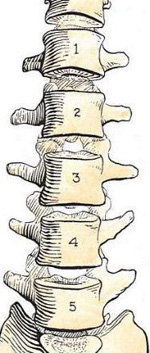 The Lumbar Spine is the part of your spine commonly referred to as your “lower back”. It consists of five large vertebrae, (L1 – L5). Although this is an area of the spine that many people recognize when they think of pain, the nerves that exit this portion of the spine have responsibilities for vital body functions. This area of your spine has the largest and strongest vertebrae and some of the largest muscles supporting it.
The Lumbar Spine is the part of your spine commonly referred to as your “lower back”. It consists of five large vertebrae, (L1 – L5). Although this is an area of the spine that many people recognize when they think of pain, the nerves that exit this portion of the spine have responsibilities for vital body functions. This area of your spine has the largest and strongest vertebrae and some of the largest muscles supporting it.
The nerves that exit from these areas are large and control some very large muscles. These muscles include the large and small muscles of the lower back, the muscles of the thigh, legs, calf muscles, and feet. The sciatic nerve has its origin from the nerves that exit from the lumbar spine. In addition to the muscles, many joints in this area are also supplied by nerves from the lumbar spine including the hips, knees, ankles and feet.
Many organs and tissues also get their nerve supply from nerves that exit from the lumbar spine. These include the large intestines, appendix, male or female reproductive organs, the bladder, prostate gland, and others.
Subluxations in these areas can have a vast affect including pain in the lower back, legs, or sciatic pain. Numbness in the back and legs is also possible. Muscle spasm or weakness can also result. Scoliosis and joint problems are also possible.
If the organs supplied by these nerves are affected, the possible results include, constipation, diarrhea, cramps, varicose veins, bladder problems, menstrual problems, infertility problems, bed wetting, urination problems, and poor circulation, among others.

The internal organs supplied by nerves from the thoracic spine include much of the body parts supplied by the sympathetic nervous system. This portion of the nervous system innervates many of the organs in the chest and abdomen including, the heart, lungs, bronchial tubes, gallbladder, liver, stomach, pancreas, spleen, adrenal glands, kidneys, and small intestines. Subluxations affecting these organs can lead to a large list of functional and systemic problems including, asthma, certain heart problems, bronchitis, blood pressure problems, ulcers, allergies, kidney trouble, and digestive problems, to name only a few. Most subluxations affecting these areas go undetected for a long time before a health problem is ever noticed.
